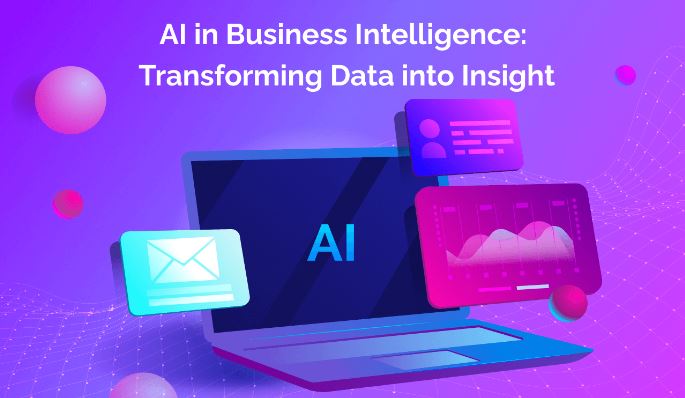In a world where every business decision counts, having accurate, actionable insights is no longer optional—it’s essential. For entrepreneurs, managers, and business leaders, the ability to turn raw data into strategic actions can mean the difference between thriving or merely surviving in today’s competitive market.
This is where AI-powered business intelligence (BI) using data comes into play. By automating data analysis, uncovering patterns, and forecasting trends, AI is taking BI tools to new heights. It’s enabling smarter decisions, better strategies, and improved risk management. Let’s explore how AI is reshaping business intelligence and why it’s an indispensable resource for modern businesses.
What Is AI in Business Intelligence?
Business intelligence involves collecting, processing, and analyzing data to support decision-making. Traditional BI tools primarily focus on reporting historical data, often leaving the interpretation and strategy development to human analysts. AI, however, revolutionizes this process.
With artificial intelligence integrated into BI tools, businesses gain predictive and prescriptive capabilities. Instead of simply answering “What happened?” AI-powered tools answer “What will happen?” and “What should we do about it?”
AI doesn’t just work faster—it works smarter. It identifies trends, predicts outcomes, and recommends actions, allowing leaders to make decisions with greater confidence and speed.
AI for Forecasting: Staying Ahead of the Curve
Forecasting has always been a cornerstone of business intelligence. However, traditional methods often fall short due to their reliance on static models and limited data sets. AI changes the game entirely by analyzing vast amounts of data from multiple sources in real-time.
AI can predict sales trends by considering historical data, market conditions, and even external factors like social media sentiment or economic indicators. This allows businesses to anticipate demand fluctuations, optimize inventory, and allocate resources efficiently.
A retail business, for example, can use AI-powered forecasting to predict seasonal demand for specific products and adjust its supply chain accordingly. The result? Reduced waste, improved customer satisfaction, and maximized profitability.
Looking for tools to integrate into your BI strategy? Check out AIToolsList for a curated selection of AI-powered solutions tailored to various business needs.
Revolutionizing Risk Management with AI
Every business faces risks, whether they’re related to financial stability, market volatility, or operational challenges. AI in BI is a powerful ally in managing these risks.
AI algorithms can analyze financial data to identify patterns that indicate potential cash flow problems. This enables businesses to take preemptive action, such as securing funding or cutting unnecessary expenses.
AI also plays a critical role in cybersecurity. By continuously monitoring network activity, AI-powered tools can detect anomalies, flag potential breaches, and recommend preventive measures. This proactive approach not only reduces risks but also protects sensitive business and customer data.
Data-Driven Strategy Development
AI-powered BI tools don’t just help businesses analyze the past or predict the future—they actively contribute to developing smarter strategies.
For example, a marketing team can use AI to analyze customer data and segment audiences based on behavior, preferences, and purchase history. This enables the creation of hyper-personalized campaigns that resonate with customers, driving higher engagement and conversion rates.
Similarly, manufacturing companies can use AI to optimize production schedules, reducing downtime and improving efficiency. AI doesn’t just provide insights—it translates them into recommendations that lead to tangible improvements.
The Benefits of AI in Business Intelligence
Integrating AI into business intelligence using data delivers a wide range of benefits:
1. Faster Insights: AI processes data at lightning speed, providing real-time insights for quicker decision-making.
2. Greater Accuracy: Advanced algorithms reduce errors, ensuring more reliable forecasts and analyses.
3. Improved Efficiency: Automation saves time and resources, allowing teams to focus on strategy rather than data crunching.
4. Scalability: AI tools handle large datasets with ease, making them suitable for businesses of all sizes.
5. Competitive Edge: Access to predictive analytics gives businesses an advantage by uncovering opportunities and addressing challenges before competitors do.
Challenges and Solutions
Like any transformative technology, implementing AI in BI comes with challenges. These include:
Data Quality: Poor data quality can compromise AI outputs. Ensuring clean, well-organized data is critical for success.
Integration: Aligning AI tools with existing BI platforms may require initial setup time and resources.
Skill Gaps: Teams may need training to interpret AI-driven insights effectively.
To address these challenges, businesses should prioritize high-quality data management, partner with trusted vendors, and invest in team training to maximize the value of AI-powered BI tools.
Steps to Implement AI in BI
1. Assess Your Needs: Identify specific areas where AI can add value, such as forecasting, reporting, or risk management.
2. Choose the Right Tools: Explore AI-powered BI platforms that align with your goals and existing systems.
3. Prepare Your Data: Ensure your data is accurate, complete, and accessible to AI algorithms.
4. Train Your Team: Equip your team with the skills to use AI tools effectively and interpret their outputs.
5. Monitor and Optimize: Continuously evaluate the performance of your AI tools and refine your approach as needed.
AI-powered business intelligence is no longer a luxury—it’s a necessity for businesses that want to stay competitive in a data-driven world. By enhancing forecasting, improving risk management, and enabling smarter strategy development, AI transforms BI into a powerhouse of actionable insights.
Ready to Transform Your Hotel Experience? Schedule a free demo today
Explore Textify’s AI membership
Need a Chart? Explore the world’s largest Chart’s database with Textify Analytics
